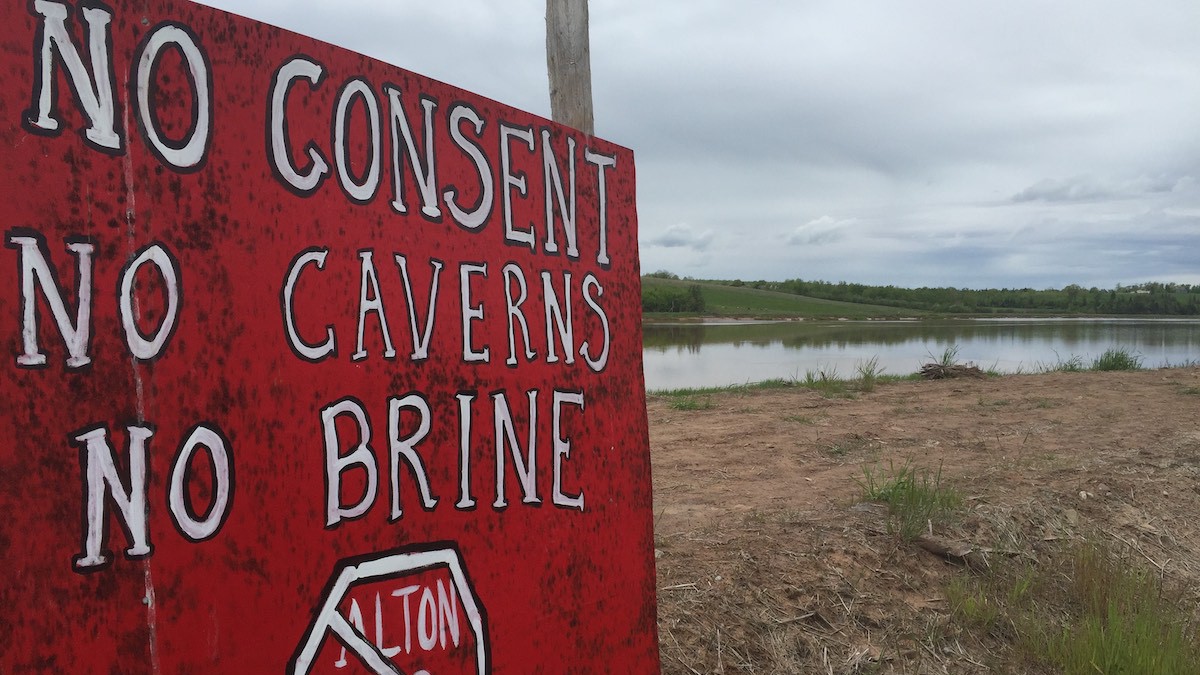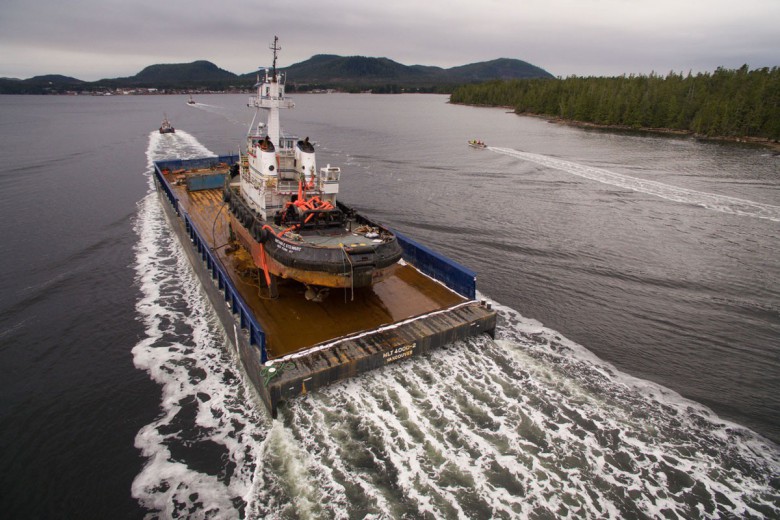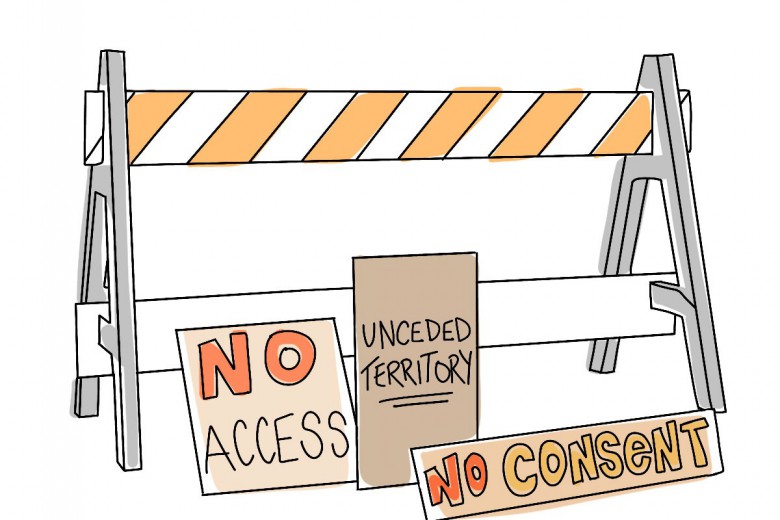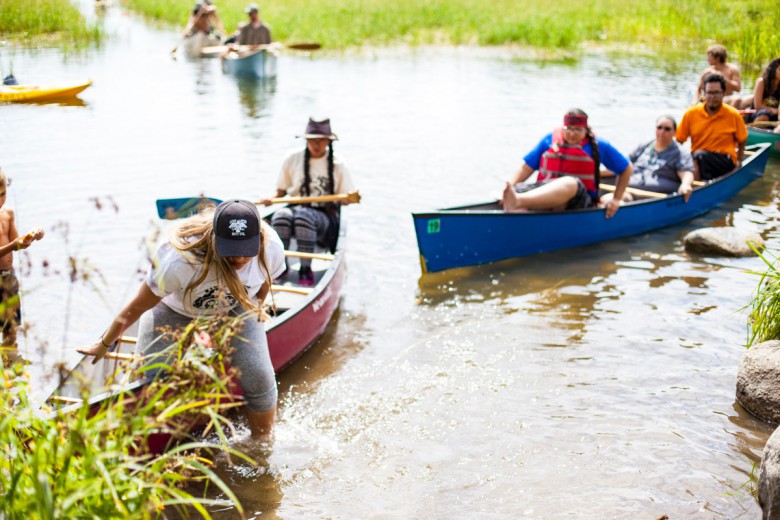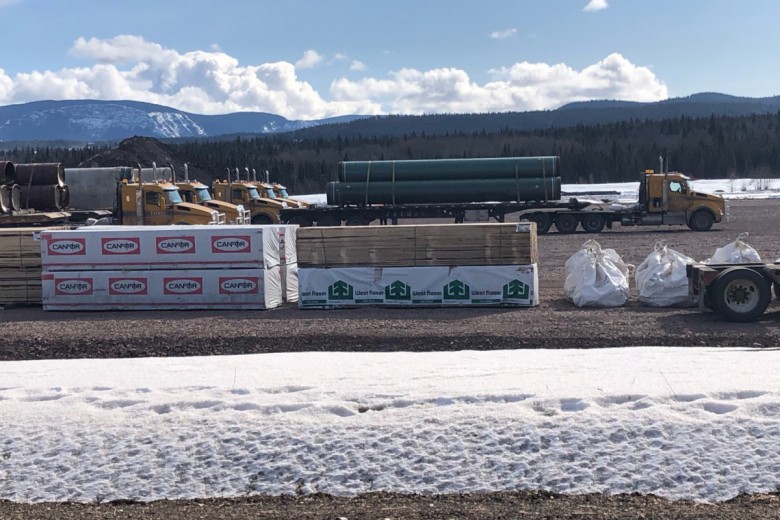It was the RCMP that gave Dale Poulette the idea to build the camp that would grow to include the “We Are All Treaty People” straw bale house in early 2017.
In September 2016, the Mi’kmaw water protector was hunkered down near the entrance to the Alton Gas natural gas storage project near Stewiacke, Nova Scotia, living in a truckhouse that was built by Mi’kmaq opponents of the project and their allies on the banks of the Sipekne'katik River. At the time, he only got the chance to sleep in a bed on the rare weekend someone would turn up to relieve him.
Then an Alton Gas worker called the cops on him, claiming that Poulette was barring him from leaving the site. “[The RCMP] said ‘Hi Dale, we respect your right to peacefully protest, but you can’t block the guy from leaving,’” Poulette recalls. “That sparked a lightbulb in my head, you know like one of those cartoon things, and then I said, ‘Holy shit, I gotta build my camp right here.’”
The Alton Gas struggle is an example of a fight where Indigenous sovereignty and the obligations of treaty were prioritized over the ideas and demands of settlers.
At the time, Poulette was opposing a project that would see natural gas stored in the salt bed caverns of the Sipekne'katik. Along with other Mi’kmaq rights holders and settler allies, Poulette set up camp at the company's gates to halt the project. That camp would eventually become a two-storey straw bale house with glass-paned windows, a smoker, a greenhouse, and a garden.
The site was a physical manifestation of the collaboration between Indigenous water defenders and settler activists – a collaboration that was grounded in shared treaty rights. “We wrote it right there on the straw bale [house],” recalls Kukuwis Wowkis, a Mi’kmaw grandmother involved in the resistance: “‘We Are All Treaty People.’”
In recent years, as Indigenous land defenders have taken courageous actions to halt the construction of pipelines, mines, and other resource-extraction projects, a robust conversation has developed around whether and how settler allies can participate in these movements. The Alton Gas struggle is an example of a fight where Indigenous sovereignty and the obligations of treaty were prioritized over the ideas and demands of settlers. In doing so, settlers took the opportunity to learn about their own rights and responsibilities as treaty people.
“A perfect collision”
In 2002, Alberta-based AltaGas began exploration on unceded Mi’kmaq territory, looking for a site where it could store natural gas underground. After settling on the rural community of Alton, Nova Scotia in 2007 the company was granted environmental approval to bore into an underground salt deposit, flush out large caverns in the salt bed, and dump that brine into the Sipekne'katik River. They plan to use the caverns to store pressurized natural gas. But the project has moved forward slowly, opposed at each step by Mi’kmaq water protectors and their allies.
Mi’kmaq rights holders say that the project would disturb the river’s ecosystem, and they say that the environmental consultations that have been done have focused primarily on striped bass eggs and larvae while ignoring other species like tommycod, Atlantic salmon, American eel, Atlantic sturgeon, and Atlantic mud piddock. While Alton claims that the brine will not impact the health of the river, Freedom of Information Act findings obtained by Poulette and his partner, Rachael Greenland-Smith, show that Alton has played fast and loose with numbers when reporting how many parts per thousand (PPT) of brine would be released into the water. Although the federal Fisheries Act prohibits the release of “deleterious substances” into the water, the Alton project would have seen 260 PPT of brine poured into the Sipekne'katik. “The whole campaign that Alton and the [provincial] government backed as well was hiding these big numbers,” says Greenland-Smith. In 2019, that information led Environment and Climate Change Canada to issue a notice of intent to create new regulations under the Fisheries Act to govern the Alton project.
Tress says the resource extraction project is “kind of like a perfect collision of corporate and colonial power just steamrolling absolutely everyone.”
“If we didn’t bring that to light, this would have gone ahead,” says Greenland-Smith. Now, while the project is technically still set to go ahead at some unknown point in the future, the drills have been moved far from the Sipekne’katik and most of those involved in the resistance believe that the project is dead.
Before Alton Gas, there seemed to be two separate environmental movements happening in Nova Scotia. “[There] was like, the settler movement and there was the Indigenous movement and they [...] a little bit overlapped,” says Robin Tress, a climate and social justice campaigner with the Council of Canadians who previously volunteered with the Nova Scotia-based Ecology Action Centre. “But then with Alton Gas they collided in a much more extreme way, and so there’s been a lot more collaboration and relationship-building through the seven years of fighting Alton Gas.”
Tress, who spent time at the Alton Gas protest camp, says the resource extraction project is “kind of like a perfect collision of corporate and colonial power just steamrolling absolutely everyone.”
In 2014, Mi’kmaq rights holders, joined by Nova Scotians, lit a sacred fire on the highway near the site and vowed to raise legal challenges to prevent the project from going ahead. Sadie Beaton, a white settler from K’jipuktuk, attended the event, which included a water walk to pray for the protection of the water. “I brought my baby that I carried on my back and I brought my three-year-old,” Beaton says. “And it was just a really beautiful experience [...] it’s kind of hard to put it into words but [...] it was beautiful and it was transformative.”
“You guys fall under our treaty, you know,” Wowkis says. “That’s how we protect you. That’s how we protect one another and help one another.”
For settlers like Beaton who wanted to participate in the resistance in a way that respected Mi’kmaq sovereignty, that meant taking stock of their involvement with mainstream environmental organizations and, at times, disengaging from them and supporting the struggle without institutional support. Beaton, who worked for the Ecology Action Centre until this spring, notes that during her time resisting Alton Gas she had to grapple with the EAC itself and its role as a settler organization.
“[EAC] has a mainstream NGO kind of structure,” Beaton says, and that structure made it hard for her to know whether her work on the Alton Gas resistance was an extension of her work for the organization, or part of her “lifelong journey to figure out how to be a settler on these lands.” Although Beaton had initially participated in the resistance in her role at the EAC, eventually “project funding dried up” and she says she was “encouraged to take on less contentious water-related projects instead.”
But Beaton knew she couldn’t walk away. “Resistance to Alton Gas is a treaty-based struggle and the strategy comes from the Mi’kmaq rights holders,” she says. Instead of looking to the hierarchical, settler-centred organization she worked for for guidance on how to proceed, she focused on building relationships with Mi’kmaq rights holders, viewing the Alton site as a place to work together with them to safeguard and assert their right to self-determination.
Some of the people she looked to included a group of Mi’kmaq women known as the “grassroots grandmothers” – that group included Kukuwis Wowkis, who, along with two others, was arrested for violating a court injunction at the Alton Gas blockade in 2019. Wowkis points out that the Peace and Friendship Treaty that governs the area – and Mi’kmaq sovereignty more broadly – is beneficial for settlers who call Mi'kma'ki home. “You guys fall under our treaty, you know,” she says. “That’s how we protect you. That’s how we protect one another and help one another.”

A treaty-based resistance
The treaty Beaton and Wowkis are referring to is the 1752 Peace and Friendship Treaty, a nation-to-nation agreement between the British and the Mi’kmaq that ceded no land and ensured that the Mi’kmaq would retain their rights over the lands that they had tended since time immemorial. The 1752 treaty, one of a series of Peace and Friendship treaties that are among the oldest in Canada, was signed not far from the Alton Gas site, in Kijipuktuk (Halifax, Nova Scotia).
Cheryl Maloney, a Mi’kmaw rights holder and direct descendent of one of the treaty’s signers, explains that “these laws are still the laws of the land.” Signers of the treaty were careful to ensure the sovereignty of their descendants, though as Beaton points out in her podcast, “Shades of Green,” “settlers have broken these sacred promises,” beginning almost as soon as the treaties were signed.
Maloney says the company, and the government, have a higher duty than “mere consultation”: such projects can only be undertaken with the full consent of the Mi’kmaq.
When it came to Alton Gas, one of the ways the treaty was undermined was through a lack of free, prior, and informed consent from the Mi’kmaq. “The nature of the treaty itself defined the relationships and the level of duties owed to the Indigenous people,” says Maloney, who has a law degree and taught political science at Cape Breton University. “This is nation-to-nation based, so therefore you can’t just go to one Indian Act chief and council and get approval” for a project like Alton Gas. Maloney says the company, and the government, have a higher duty than “mere consultation”: such projects can only be undertaken with the full consent of the Mi’kmaq.
In an effort to help settlers learn to keep Mi’kmaq sovereignty at the forefront of their attempts to support the struggle against Alton Gas, Beaton became involved with a group called Solidarity with Alton Gas Resistance (SWAGR). SWAGR focused on fundraising and educating settlers on how to respectfully engage with and support the resistance to the storage project. At times, that meant refusing support from organizations that weren’t prepared to center Mi’kmaq sovereignty and treaty. “We were working in solidarity with the grandmothers and we had agreed that the fight was treaty-based,” Beaton explains. At other times, SWAGR’s work involved communicating with groups who were eager to participate in resisting Alton Gas, but were ignorant about how to do so in a way that respected Mi’kmaq sovereignty and leadership.
She says the environmental group Extinction Rebellion was particularly enthusiastic about supporting the resistance, but they needed guidance on how to participate in ways that respected the sovereignty and leadership of Mi’kmaq rights holders. “They would plan things and not talk to the grandmothers,” she says. “They put an emphasis on ‘arrestable actions’ and invited Mi’kmaq youth to participate without communicating the risks, and without an understanding or acknowledgement that being arrested as a white guy has very different implications that being arrested as an Indigenous youth.” Extinction Rebellion emphasizes tactics of non-violent disruption, like blockades, graffiti, and other illegal actions, without always considering the vastly different consequences such actions can have for non-white protestors. Allyship in that context meant setting aside settler ideas of what needs to be done, and following the guidance of Mi’kmaq rights holders instead.
“We were working in solidarity with the grandmothers and we had agreed that the fight was treaty-based,” Beaton explains.
Sometimes allyship meant taking direction to use white privilege strategically. Maloney says that one day, when she was taking her son to hockey practice, a neighbour told her, “Cheryl it looks like it’s an Indigenous protest, an Indian protest.” Maloney recognized that Nova Scotians needed to see that the resistance was multi-racial, because dumping brine into the river was an environmental catastrophe that impacted everyone, not just the Mi’kmaq. “So I went back to my group and I said, ‘Okay, we’ve got to do something and it’s got to be the white people that do it,’” she recalls. She got white residents from the area to put together a news release, prepare spokespeople, and organize a car caravan. Mi’kmaq – including Maloney – were there, “but we’re in the back line and clear instructions to show no brown faces, no feathers, no nothing. This has to be a Nova Scotian issue, movement, action,” she explains.
Building the truckhouse
Like Wowkis, Maloney wants settlers to understand that the treaties signed by the Mi’kmaq nearly 300 years ago offer them dignity and protection that they don’t have under Canadian law. “There’s no laws in Canada for Nova Scotians,” she says, referring to the ways in which Canadian law so often favours corporations and the wealthy over ordinary people. “There’s no laws in Canada protecting any of your guys’ right to water, hunt, fish, trade, live, be healthy. You guys have nothing.”
That idea of treaty as a foundation and a shelter for both Indigenous rights holders and settlers was embodied by the treaty truckhouse, a small structure water protectors built near the river in 2016. “We use[d] the treaty clauses to establish a truckhouse on the river, which gave Canadians and Mi’kmaq a Treaty Right to go and cross Alton’s lands, or government lands to get to the truckhouse,” explains Maloney. A truckhouse is a structure set up for Mi’kmaq to meet and trade goods and fish – but because the treaty promises that rights holders can set up a truckhouse wherever they consider it “needful,” neither Alton nor the government had any right to remove the structure. “So it made it legal,” Maloney explains. “Where they were saying we were trespassing, we were like ‘no, there’s a truckhouse there. We have the legal right to pass.’”
Meanwhile, the straw bale house was built at the gates of the Alton Gas project in 2017. The house was constructed in ceremony, with Mi’kmaq rights holders laying down tobacco and setting intentions for how the structure would be built and used. Together with settler allies, they laid the sandbags and levelled the foundation, mixed the clay that would hold together the straw bales, and constructed the roof, painting it with the words “We Are All Treaty People.”
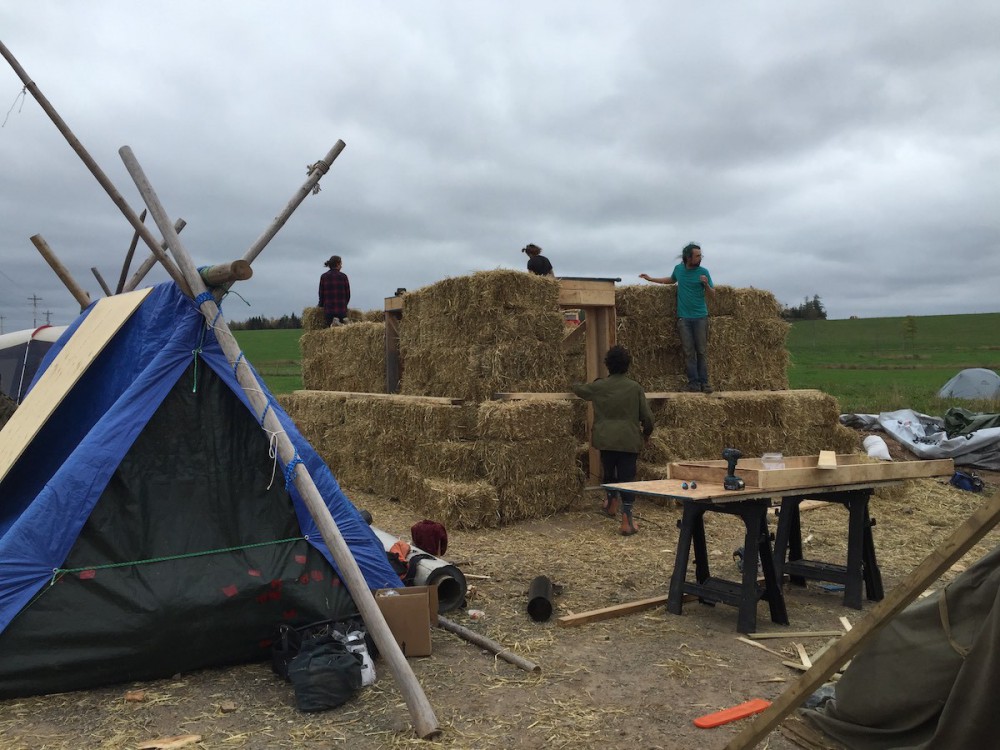
Poulette says the house was a place of education, where people who knew little to nothing about treaty could learn about their rights and responsibilities. “Everybody was helpful,” he says of the settlers who came to the site. “And I think half of them didn’t know what treaty rights were, but were there to learn.” And although many “didn’t know they were even on unceded Mi’kmaq territory,” he says he “broke it down to them about the history and a little bit about sovereignty.”
Although the straw bale house is now gone – it was demolished by Alton Gas in April 2019 – those lessons and the intentions that were set in 2017 remain. “We had great relationships with our allies,” Wowkis says, “and we built these buildings together.”
For now, the Alton Gas project is on hold, and so is much of the resistance. The company had to pause their work in March 2020, when their industrial approval was suspended, and fluctuations in the price of natural gas mean the project may not be as profitable as expected. “The economic case is not there” to support the project, Beaton says. Although the company maintains a presence in the area, without the drills, that presence is largely toothless.
Meanwhile, the legacy of the protest camp lingers. “The structure of the protest camp was like a sign of hope for [...] environmental justice,” Poulette says. “A lot of people I met anyway were happy to see that there was actually people fightin’.” And until the project is abandoned completely, the Mi’kmaq and their allies will stay vigilant.
“There’s still a lot of support out there,” Wowkis says. “That’s what’s scaring the government. That’s what’s scaring Alton Gas. [...] We know we’re going to beat them. We just know it. Just got to wait it out.
Update, September 17, 2021: This article conflated the straw bale house with the treaty truckhouse, and has been update to clarify the distinction between the two.
The author conducted research and interviews for this article as part of the Corporate Mapping Project, a research and public engagement initiative investigating the power of the fossil fuel industry in Western Canada. The CMP is jointly led by the University of Victoria, Canadian Centre for Policy Alternatives, and the Parkland Institute.


